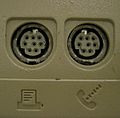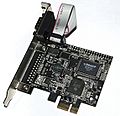Serial port facts for kids
A serial port is a special connection on a computer that lets it send and receive information one tiny piece (called a bit) at a time. Think of it like a single-lane road where cars (bits of data) have to go one after another. This is different from a parallel port, which is like a multi-lane highway where many cars can travel side-by-side at the same time.
For a long time, serial ports were very common. They were used to connect computers to many different devices, like terminals (which were like basic computer screens) and other helpful tools.
Even though newer connections like Ethernet, FireWire, and USB also send data one bit at a time, the term "serial port" usually refers to a specific type of connection that follows the RS-232 standard. These were often used to connect to modems or similar communication devices.
Today, the USB connection has mostly replaced the older serial ports for many computer devices. While you'll still find serial ports on almost every server (powerful computers that manage networks), many newer workstations and laptops don't have them anymore. They are seen as an older type of connection, sometimes called a "legacy port", and are often left out to save money.
However, serial ports are still very useful in certain areas! You can find them in industrial systems, scientific labs, and even in point of sale systems (like cash registers). Network devices, such as routers and switches, often have serial ports for setting them up. They are still used in these places because they are simple, cheap, and reliable for devices to talk to each other.
Contents
What is a Serial Port?
A serial port is a physical connection on a computer. It allows data to move in or out of the computer. The key thing about a serial port is that it sends data in a series, one bit after another. This method is simple and effective for many types of communication.
How Does a Serial Port Work?
Imagine you have a message to send. With a serial port, your computer breaks that message down into tiny pieces. Then, it sends each piece one by one, in a specific order, over a single wire. The receiving device then puts all those pieces back together to understand the message. This step-by-step process makes sure the data arrives correctly.
Why Were Serial Ports Important?
For many years, serial ports were a vital part of personal computers. They allowed computers to connect with a wide range of external devices.
Connecting Devices to Computers
Early computers used serial ports to link up with things like:
- Terminals: These were basic screens and keyboards that allowed users to interact with the computer.
- Modems: Devices that let computers send data over phone lines, connecting to the internet before broadband was common.
- Printers: Some older printers used serial connections to receive documents from the computer.
- Mice and Keyboards: Before USB, some of these input devices also used serial ports.
Modern Uses of Serial Ports
Even though USB is more common for everyday devices, serial ports are still very important in specific fields.
Where Are Serial Ports Still Used?
You might find serial ports in:
- Industrial Systems: They control machinery and equipment in factories.
- Scientific Equipment: Labs use them to connect to sensors and measurement tools.
- Point of Sale Systems: These are used in shops for things like barcode scanners or receipt printers.
- Network Devices: Routers and switches often have a serial port for engineers to configure them.
- Embedded Systems: Small computers built into other devices, like some smart home gadgets.
Benefits of Serial Ports Today
Serial ports continue to be used in these areas because they offer several advantages:
- Simplicity: They are easy to understand and use for basic communication.
- Cost-Effective: The hardware needed for serial ports is often inexpensive.
- Reliability: They are known for being stable and dependable for data transfer.
Images for kids
See also
 In Spanish: Puerto serie para niños
In Spanish: Puerto serie para niños










